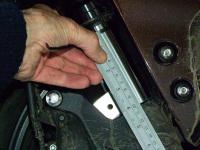mcatrophy
Privileged to ride a 2018 FJR1300AS
I've never been fully happy with my 2014 FJR1300AS that has the "ES" suspension. Whilst it's always given me the utmost confidence in riding, it's been relatively uncomfortable.
I've improved this somewhat by reducing the front tyre pressure form "my" 40-odd psi to nearer the Yamaha recommendation of 36 psi. Posted about this here.
My gut feel is that my suspension is too stiff. In order to get some sort of handle on this, I've done some sag measurements. While I am aware of some of the terms used ("static", "dynamic"), I've seen different definitions of these, so I'm not using them, instead I'm being purely descriptive.
I weigh about 145 without gear. I use the bike for shopping, playing in country lanes, touring consisting of slab right through to mountainous regions.
All the measurements were made as I usually have the suspension, rider only, hard + 0.
1) Front off the ground (blocks under the headers), length of the exposed fork tube with no weight on the front wheel: 135mm.
2) Bike on centre-stand, so some weight on the front wheel, no rider: 133mm -> 2mm sag (probably a useless measurement)
3) Bike on side-stand, no rider, so a bit more weight on the front wheel, steering straight: 110mm -> 25mm sag (probably a useless measurement)
Using a plastic wire-tie round the fork tube, pushed up against the seal, then gently pulled the bike upright. Lowered it back onto the side-stand.
4) Length measured to top of wire-tie, bike's weight, no rider: 102mm -> 33mm sag ("Static" sag?)
5) Gently got on the bike, balanced as best as I could, then gently off the bike, so after rider sat on bike: 97mm -> 38mm sag ("Dynamic" sag"?)
6) Finally I stood beside the bike, front brake on, pumped down as hard as my limited weight and advancing years let me, length measured after pumping: 53mm -> 82mm sag(?).
In summary, probably the most useful measurements:
Front sag with bike only: 33mm
Front sag with rider: 38mm
So, are these reasonable numbers?
I took a few pictures to show what I was doing. Typical measurement method:
(Click on image for larger view)

They all can be viewed here.
I've improved this somewhat by reducing the front tyre pressure form "my" 40-odd psi to nearer the Yamaha recommendation of 36 psi. Posted about this here.
My gut feel is that my suspension is too stiff. In order to get some sort of handle on this, I've done some sag measurements. While I am aware of some of the terms used ("static", "dynamic"), I've seen different definitions of these, so I'm not using them, instead I'm being purely descriptive.
I weigh about 145 without gear. I use the bike for shopping, playing in country lanes, touring consisting of slab right through to mountainous regions.
All the measurements were made as I usually have the suspension, rider only, hard + 0.
1) Front off the ground (blocks under the headers), length of the exposed fork tube with no weight on the front wheel: 135mm.
2) Bike on centre-stand, so some weight on the front wheel, no rider: 133mm -> 2mm sag (probably a useless measurement)
3) Bike on side-stand, no rider, so a bit more weight on the front wheel, steering straight: 110mm -> 25mm sag (probably a useless measurement)
Using a plastic wire-tie round the fork tube, pushed up against the seal, then gently pulled the bike upright. Lowered it back onto the side-stand.
4) Length measured to top of wire-tie, bike's weight, no rider: 102mm -> 33mm sag ("Static" sag?)
5) Gently got on the bike, balanced as best as I could, then gently off the bike, so after rider sat on bike: 97mm -> 38mm sag ("Dynamic" sag"?)
6) Finally I stood beside the bike, front brake on, pumped down as hard as my limited weight and advancing years let me, length measured after pumping: 53mm -> 82mm sag(?).
In summary, probably the most useful measurements:
Front sag with bike only: 33mm
Front sag with rider: 38mm
So, are these reasonable numbers?
I took a few pictures to show what I was doing. Typical measurement method:
(Click on image for larger view)

They all can be viewed here.













